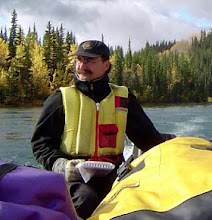Ohope Beach stretchs east for about 10 km beyond Te Rangi Point, before folding back on itself to reveal one of the largest harbour bays in New Zealand. I ride the Beach Hopper bus from Whakatane to the end of the line, the last houses on Ohope peninsula, and walk through the long grasses, native trees and wild flowers of a Maori holding to the bay shore. Mid-morning - the sun is hot and in the lee of the peninsula, the water is calm, there is no wind. The beach, with the tide just returning, is a wide, empty space of fine hard sand.
 |
| James casts into deep waters, next cast is into the police force. |
I head back into the dunes, a native bird preserve. The vegetation is thick. There is a high profile campaign to protect vegetation to ensure the stability of the dunes and permanence of the splendid beach. I stir up some pheasants but it is otherwise still while I patrol through the shrubs. Gradually the sound of waves floats over the dunes and I return to the beach.
 |
| The bay channel reaches the ocean, wind, sand and spray. |
The bay channel ends and the roll of the Pacific Ocean against the shores of this small island reminds me how far I am away from home. The wind is powerful and runs straight down the beach into my face. There is a constantly shifting flow of sand blowing past my ankles. To the west I see Motuhora which marks the beach at Whakatane. But there is not much to see beyond the details immediately before me; broken shells, beautifully wind-polished bits of wood and one set of bare foot prints proceeding me. I take off my shoes and head for the water. The shallow water is warm, it swirls cross the rippled sand, blown by the wind and crazing my view of the sand and shells just covered by its sheen. It is very relaxing and I move slowly through this liquid vision.
 |
| 66 mediates the batt;le between Mother Nature and local access. |
W: “So what are you working at here?”
66: “Oh, I'm replacing the posts, wire and board on the walkway.”
W: “Doing this on your own are you?”
66: “No, no. Working for the district council. District council owns the walkway. Where do you live then?”
W: “#26 over there” nodding down the street.
66: “So do you know Jim Mason then?”
W: “He lives right in behind.”
66: “Ahh, he's my mate.”
W: “Well, it's not like I've had drinks with him, you know.”
66: “Yeahh, he's my good mate.”
W: “Well, I'm off then.”
66 turns and grins at me.
 |
| The modernist curved architecture of the 1920s and 30s is a prominent part of the North Island's housing stock. |








Here's a dog free Ohope Beach for you Murray.
ReplyDeleteBeautiful and peaceful, just as we remember it :)
ReplyDelete